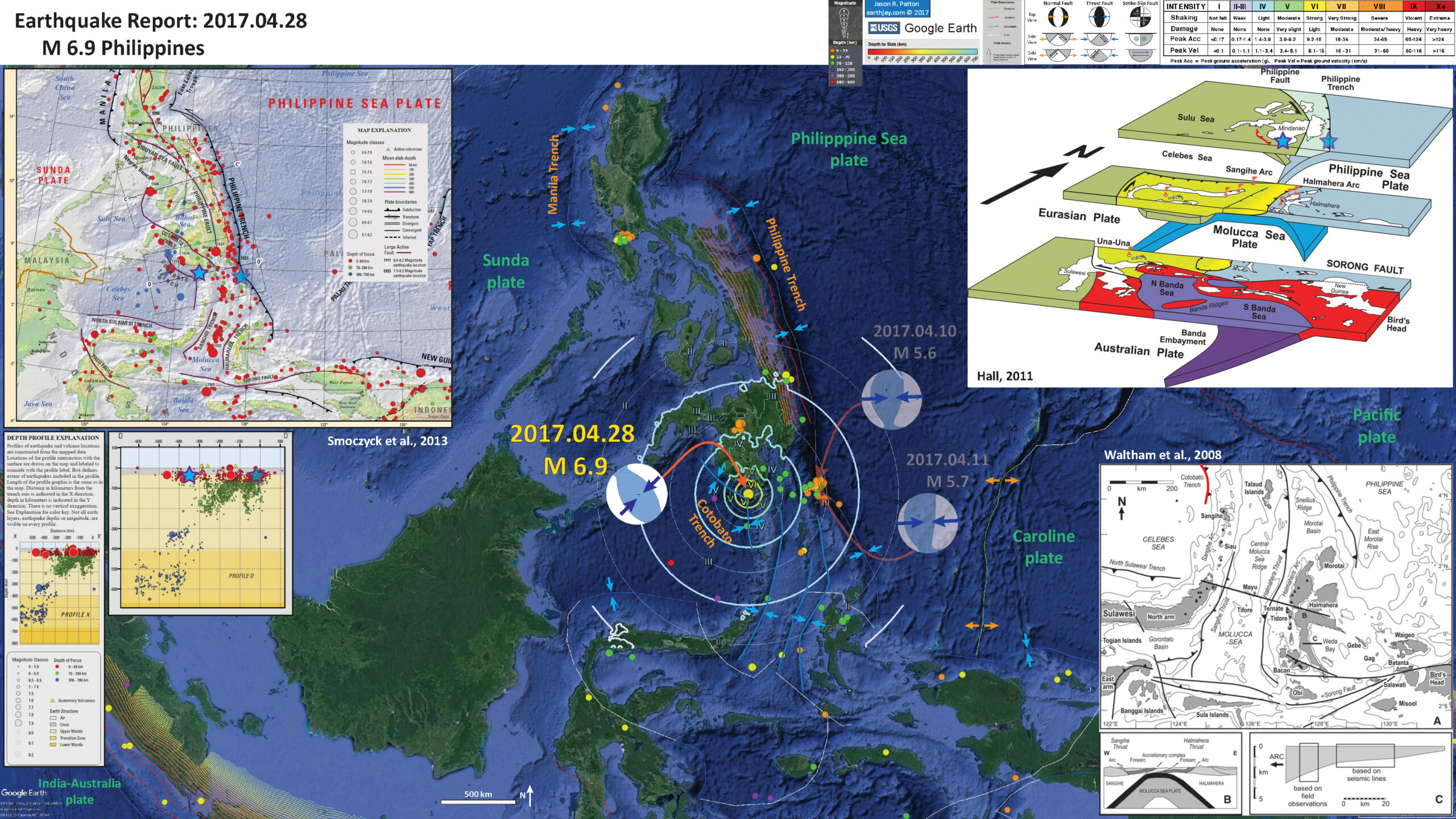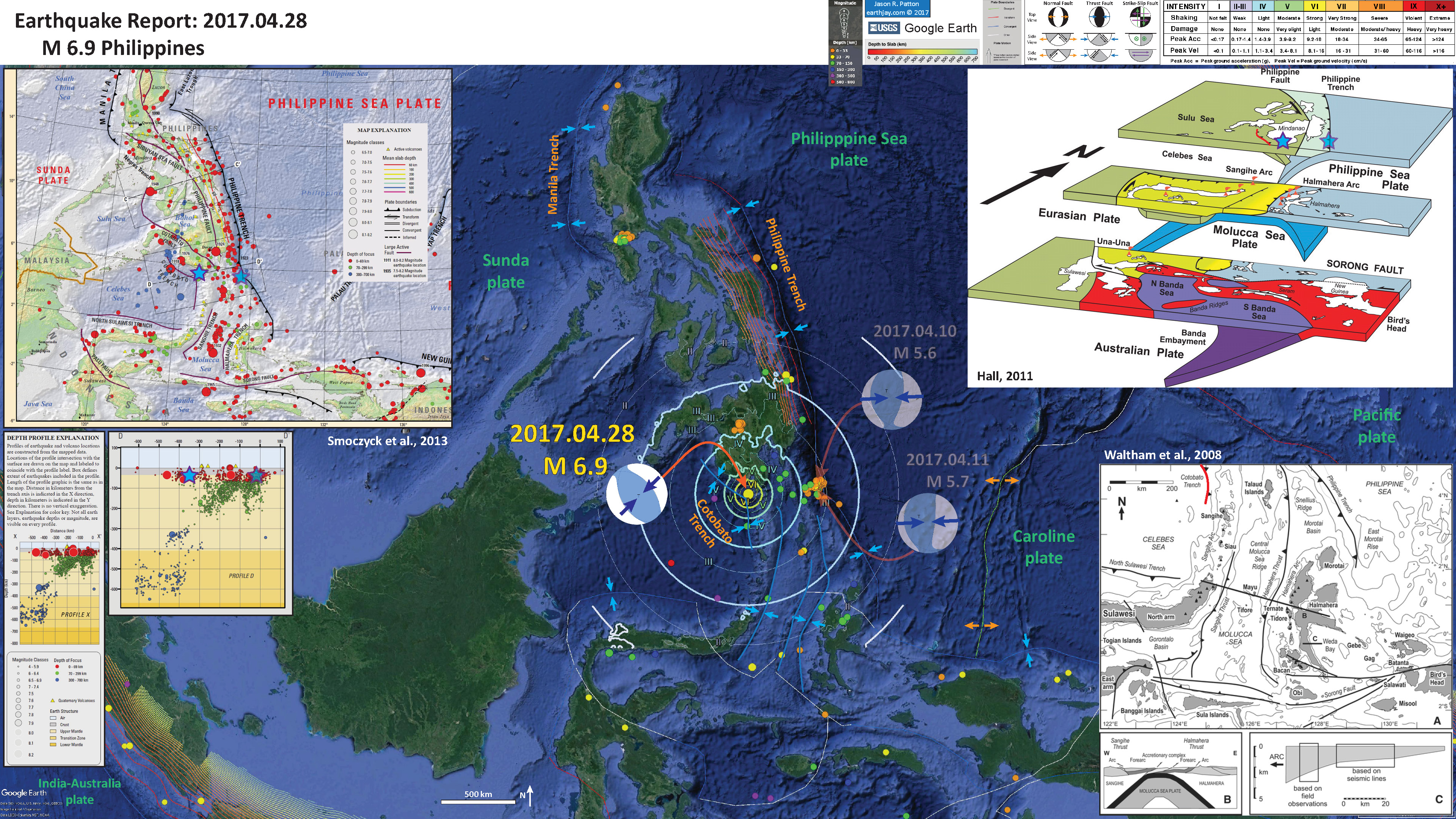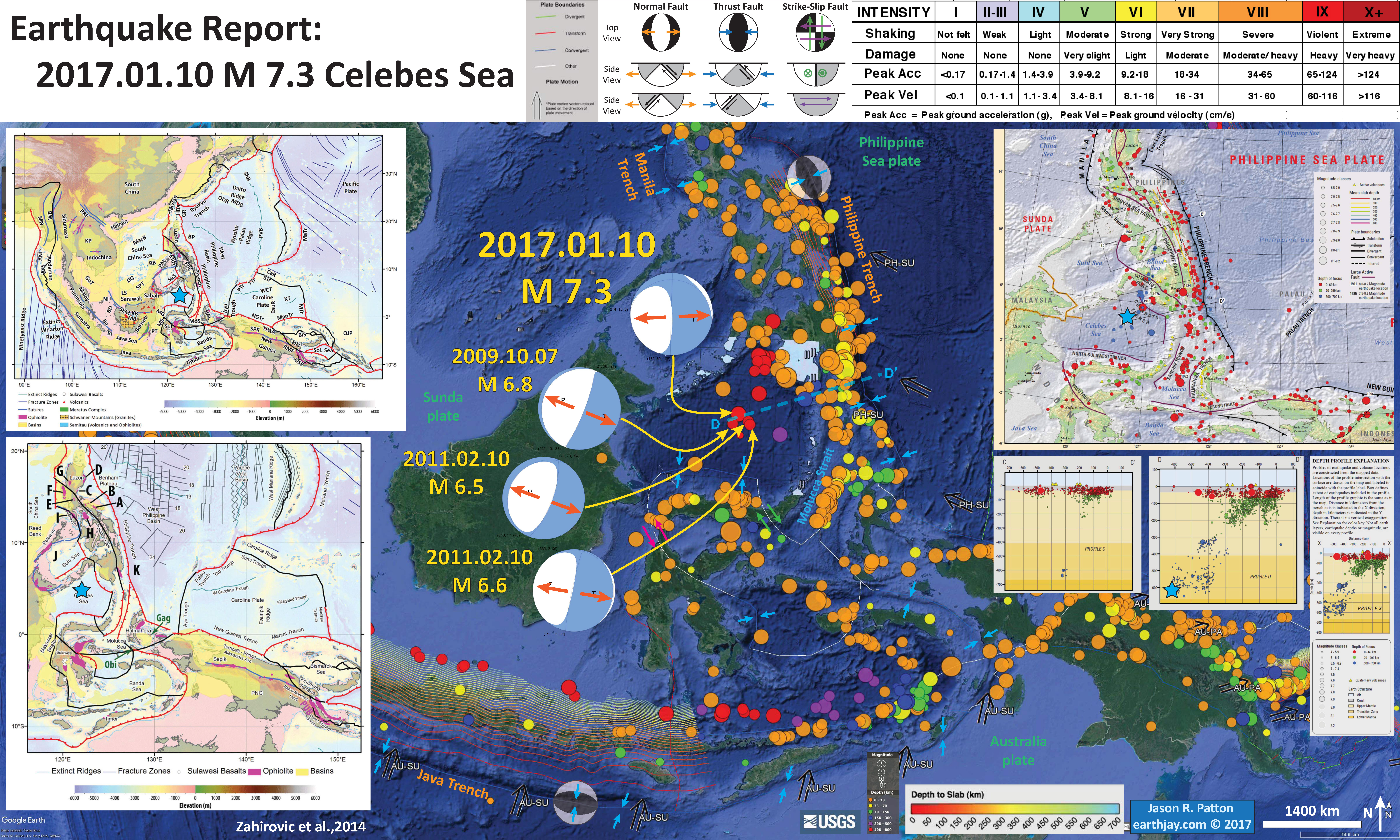Earlier in April (2017) there was some activity in 4 different regions of the Philippines. Based upon the low magnitudes and large epicentral distances, these earthquakes were most unlikely to be directly related to each other.
A couple days ago, there was an earthquake along-dip from one of these earlier swarms. Here is the USGS web page for this M 6.9 earthquake.
There does not appear to have been an observed tsunami based upon a quick look at gages posted to this IOC site (though the closest 2 gages seem to have intermittent records).
The along dip seismicity earlier this month was along the Philippine trench subduction zone fault. The M 6.9 earthquake appears to be related to subduction along the Cotobato trench.
These earthquakes are ~300 km from each other. Also, the Philippine trench swarm appears to possibly have reduced stress on the Cotobato trench, but I might be wrong. Regardless, it is probably a coincidence that these earthquakes are along dip to each other.
Another coincidence is another earthquake along-dip to these earthquakes, a deep M 7.3 earthquake in the Celebes Sea in January 2017. Here is my earthquake report for this earthquake.
- This is my Earthquake Report for these earlier earthquakes.
- Here is another blog about the earthquakes near Manila (including the M 5.9): Stephen Hicks
- UPDATE: here is the Berkeley Seismo Blog page for these earthquakes.
- Here is another blog about the earthquakes near Manila (including the M 5.9): Stephen Hicks
- Here is the Berkeley Seismo Blog page for these earthquakes.
Below is my interpretive poster for this earthquake.
I plot the seismicity from the past month, with color representing depth and diameter representing magnitude (see legend).
- I placed a moment tensor / focal mechanism legend on the poster. There is more material from the USGS web sites about moment tensors and focal mechanisms (the beach ball symbols). Both moment tensors and focal mechanisms are solutions to seismologic data that reveal two possible interpretations for fault orientation and sense of motion. One must use other information, like the regional tectonics, to interpret which of the two possibilities is more likely.
- I also include the shaking intensity contours on the map. These use the Modified Mercalli Intensity Scale (MMI; see the legend on the map). This is based upon a computer model estimate of ground motions, different from the “Did You Feel It?” estimate of ground motions that is actually based on real observations. The MMI is a qualitative measure of shaking intensity. More on the MMI scale can be found here and here. This is based upon a computer model estimate of ground motions, different from the “Did You Feel It?” estimate of ground motions that is actually based on real observations.
- I include the slab contours plotted (Hayes et al., 2012), which are contours that represent the depth to the subduction zone fault. These are mostly based upon seismicity. The depths of the earthquakes have considerable error and do not all occur along the subduction zone faults, so these slab contours are simply the best estimate for the location of the fault.
- In the upper right corner is a figure from Hall (2011). This shows the plate tectonic configuration in the equatorial Pacific with a low angle oblique perspective. Note how the upper panel shows a west dipping slab on the east side of the Philippines. Note the contrast in the center panel (Halmahera), where the eastern fault is dipping to the east (westward vergent) and the western fault is dipping to the west (eastward vergent). This region near Halmahera forms the Molucca Strait, one of the most tectonically active areas in this region.
- In the upper left corner is a map showing the regional tectonics from Smoczyck et al. (2013). Earthquakes are plotted with color representing depth and diameter representing magnitude (see legend). The Philippine trench is an eastward vergent (dipping to the west) subduction zone on the east side of the Philippines. The Manila trench and Cotoban trench are westward vergent (dipping to the east) subduction zone faults on the western side of the Philippines. Below the map I include the cross section showing earthquake hypocenters from this Smoczyck et al. (2013) publication (see legend). I placed a blue star in the general location of the M 6.9 Cotobato trench earthquake and a transparent blue star in the region of the M 5.6 and M 5.7 Philippine trench earthquakes on both the map and the cross section.
- In the lower right corner I include a map showing the tectonics from the Molucca Sea (Waltham et al., 2008). I highlit the Cotobato trench in red. This map overlaps with the southern 75% of the Hall (2011) low-angle oblique figure above. This is a really interesting configuration. To the north, the subduction zones oppose each other (eastward vergent on the east and westward vergent on the west). Along the latitude of the Molucca Strait, the uppermost thrust faults have a similar opposing vergence. In contrast, the molucca sea plate is below these more shallow thrusts and forms opposing subduction zones with different polarity (eastward vergent on the east and westward vergent on the west).
I include some inset figures in the poster.
- Here is my poster for the earthquakes earlier this month.
- This is the low-angle oblique view of the region (Hall, 2011).
3D cartoon of plate boundaries in the Molucca Sea region modified from Hall et al. (1995). Although seismicity identifies a number of plates there are no continuous boundaries, and the Cotobato, North Sulawesi and Philippine Trenches are all intraplate features. The apparent distinction between different crust types, such as Australian continental crust and oceanic crust of the Philippine and Molucca Sea, is partly a boundary inactive since the Early Miocene (east Sulawesi) and partly a younger but now probably inactive boundary of the Sorong Fault. The upper crust of this entire region is deforming in a much more continuous way than suggested by this cartoon.
- This is the tectonic map from Waltham et al. (2008)
(A) Location and major tectonic features of the Molucca Sea region. Small, black-filled triangles are modern volcanoes. Bathymetric contours are at 200, 2000, 4000, and 6000 m. Large barbed lines are subduction zones, and small barbed lines are thrusts. (B) Cross section across the Halmahera and Sangihe Arcs on section line B. Thrusts on each side of the Molucca Sea are directed outward toward the adjacent arcs, although the subducting Molucca Sea plate dips east beneath Halmahera and west below the Sangihe Arc. (C) Inset is the restored cross section of the Miocene–Pliocene Weda Bay Basin of SW Halmahera on section line C, fl attened to the Pliocene unconformity, showing estimated thickness of the section.
- This is smaller scale tectonic map of the region (Zahirovic et al., 2014).
Regional tectonic setting with plate boundaries (MORs/transforms = black, subduction zones = teethed red) from Bird (2003) and ophiolite belts representing sutures modified from Hutchison (1975) and Baldwin et al. (2012). West Sulawesi basalts are from Polvé et al. (1997), fracture zones are from Matthews et al. (2011) and basin outlines are from Hearn et al. (2003). ANI – Andaman and Nicobar Islands, BD– Billiton Depression, Ba – Bangka Island, BI – Belitung (Billiton) Island, BiS – Bismarck Sea, BP – Benham Plateau, CaR – Caroline Ridge, CS – Celebes Sea, DG– Dangerous Grounds, EauR – Eauripik Ridge, FIN – Finisterre Terrane, GoT – Gulf of Thailand, GR– Gagua Ridge, HAL– Halmahera, HBa – Huatung Basin, KB–Ketungau Basin, KP – Khorat Platform, KT – Kiilsgaard Trough, LS – Luconia Shoals, MacB – Macclesfield Bank, ManTr – Manus Trench, MaTr – Mariana Trench, MB– Melawi Basin, MDB– Minami Daito Basin, MG– Mangkalihat, MIN – Mindoro, MN– Mawgyi Nappe, MoS – Molucca Sea, MS– Makassar Straits, MTr – Mussau Trench, NGTr – New Guinea Trench, NI – Natuna Islands, ODR– Oki Daito Ridge, OJP –Ontong Java Plateau, OSF – Owen Stanley Fault, PAL – Palawan, PhF – Philippine Fault, PT – Paternoster Platform, PTr – Palau Trench, PVB – Parece Vela Basin, RB – Reed Bank, RMF– Ramu-Markham Fault, RRF – Red River fault, SEM– Semitau, ShB – Shikoku Basin, Sol. Sea – Solomon Sea, SPK – Sepik, SPT – abah–Palawan Trough, STr – Sorol Trough, Sul – Sulawesi, SuS – Sulu Sea, TPAA– Torricelli–Prince Alexander Arc, WB–West Burma, WCT–W Caroline Trough, YTr –Yap Trough.
- This is a map and series of cross sections showing subducting plates in blue (Zahirovic et al., 2014). The cross sections are based upon seismic wave tomography, which is similar to CT scans (Computed Tomography of X-Rays). These two processes use the same general methods to investigate the 3-dimensional views of internal structures (bodies vs. the Earth). More can be found in their paper, but basically, the blue regions represent areas that have higher seismic velocity. Oceanic lithosphere has higher seismic velocities than the surrounding mantle. So, the subducting oceanic slabs show up as blue. The corss section G-G’ is at about the same latitude as the M 5.6-7 and M 6.9 earthquakes. Note that the Philippine sea plate subducting at the Philippine trench (dipping to the west/left) is evident, while the slab associated with the Cotobato trench does not appear visible. Compare this with the seismicity cross section from Smoczyck et al. (2013), where the Cotobato trench seismicity is much more shallow than the Philippine trench.
Vertical sections from MIT-P (Li et al., 2008) and GyPSuM-S (Simmons et al., 2009) seismic tomography models along profiles A to E (magenta lines). The first-order differences between the P- and S-wave models is that the amplitude of the positive seismic velocity anomalies significantly diminishes away from continental coverage (e.g., dashed lines in profiles A and B). A depth slice at 746 km from MIT-P isprovided for reference with super-imposed present-day coastlines and plate boundaries. Interpreted slab sources are labeled: GI-BA= Greater India–Neo-Tethyan back-arc slab, M/N-T – Meso- and Neo-Tethyan slabs, W-S –Woyla–Sunda slabs, S – Sunda slab, PSCS – proto-South China Sea slab, PAC – Pacific slab, PMOL– proto-Molucca slab, PSOL – proto-Solomon slab, CS – Caroline slab, PSP – Philippine Sea Plate slab, S-C = Sulu–Celebes slabs.
- However, here is a figure that shows isosurfaces from their tomography models (Zahirovic et al., 2014). This shows what may be slabs related to the Cotobato trench (western part of G-G’ cross section). These slabs show up better on the lower figure.
3-D visualization of +0.2% seismic velocity anomaly isosurfaces in MIT-P (top) and +0.9% seismic velocity perturbation in GyPSuM-S (bottom) models. Profiles A to G represent the vertical profiles (see Fig. 10) that capture the convergence and subduction histories of the region since the Cretaceous. Present-day coastlines are translucent grey shades, and present-day plate boundaries are translucent black lines. Slab volumes are colored by their depth, while the light blue color represents the interior surface of these slabs. PSCS – proto-South China Sea slab.
- In January of this year (2017), there was an M 7.3 earthquake in the Celebes Sea south of the Philippines. Below is my interpretive map for that earthquake. I also present the same poster with 1917-2017 seismicity for earthquakes M ≥ 6.5. Here is my earthquake report for this M 7.3 earthquake. I include more background information for the Molucca Strait region on this page.
References:
- Bock et al., 2003. Crustal motion in Indonesia from Global Positioning System measurements in JGR, v./ 108, no. B8, 2367, doi:10.1029/2001JB000324
- Hall, R., 2011. Australia–SE Asia collision: plate tectonics and crustal flow in Hall, R., Cottam, M. A. &Wilson, M. E. J. (eds) The SE Asian Gateway: History and Tectonics of the Australia–Asia Collision. Geological Society, London, Special Publications, 355, 75–109.
- Hayes, G.P., Wald, D.J., and Johnson, R.L., 2012. Slab1.0: A three-dimensional model of global subduction zone geometries in, J. Geophys. Res., 117, B01302, doi:10.1029/2011JB008524
- McCaffrey, R., Silver, E.A., and Raitt, R.W., 1980. Crustal Structure of the Molucca Sea Collision Zone, Indonesia in The Tectonic and Geologic Evolution of Southeast Asian Seas and Islands-Geophysical Monograph 23, p. 161-177.
- Nelson, A.R., Personius, S.F., Rimando, R.E., Punongbayan, R.S., Tungol, N, Mirabueno, H., and Rasdas, A., 2000. Multiple Large Earthquakes in the Past 1500 Years on a Fault in Metropolitan Manila, the Philippines in BSSA vol. 90, p. 73-85.
- Noda, A., 2013. Strike-Slip Basin – Its Configuration and Sedimentary Facies in Mechanism of Sedimentary Basin Formation – Multidisciplinary Approach on Active Plate Margins http://www.intechopen.com/books/mechanism-of-sedimentarybasin-formation-multidisciplinary-approach-on-active-plate-margins http://dx.doi.org/10.5772/56593
- Smoczyk, G.M., Hayes, G.P., Hamburger, M.W., Benz, H.M., Villaseñor, Antonio, and Furlong, K.P., 2013. Seismicity of the Earth 1900–2012 Philippine Sea plate and vicinity: U.S. Geological Survey Open-File Report 2010–1083-M, 1 sheet, scale 1:10,000,000.
- Waltham et al., 2008. Basin formation by volcanic arc loading in GSA Special Papers 2008, v. 436, p. 11-26.
- Zahirovic et al., 2014. The Cretaceous and Cenozoic tectonic evolution of Southeast Asia in Solid Earth, v. 5, p. 227-273, doi:10.5194/se-5-227-2014.






